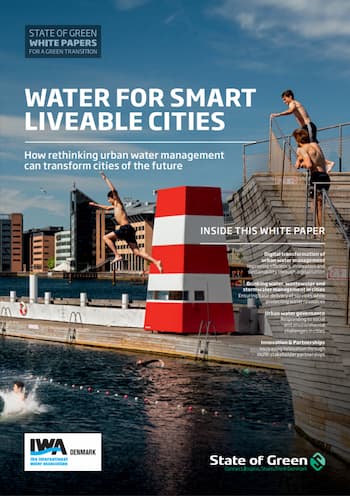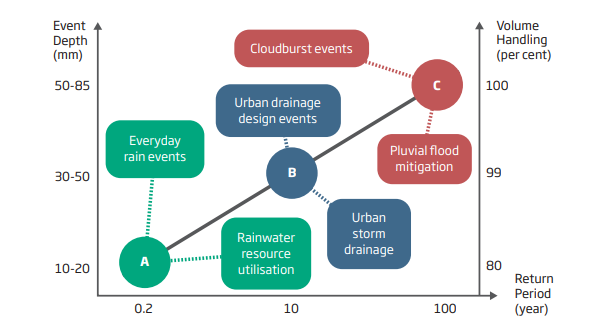Download our publication on water for smart liveable cities today
This article is part of our publication ‘Water for smart liveable cities’
Download nowPerspective
Urban planning and development
Urban water management
Water management


Water management in the liveable city is dependent on hydraulic infrastructure both below and above the surface. Many different professionals therefore influence planning and design processes related to stormwater management, and decisions are often made at the interface between three main considerations (as illustrated in the figure below): (A) rainwater resource utilisation considering ‘everyday rain events’, (B) urban storm drainage considering ‘design events’, and (C) pluvial flood mitigation considering ‘cloudburst events’. Cloudbursts are short-duration, intense rainfall events that exceed the capacity of the underground sewer system and can cause flash flooding and disruption of critical functions in the city. Solutions rely on a combination of the processes; storage, evapotranspiration, infiltration, transportation (conveyance) and purification.

This article is part of our publication ‘Water for smart liveable cities’
Download nowDuring everyday rain events and design storms in Denmark, runoff is traditionally collected, transported and delayed in underground pipe networks (combined or separate sewers). These are now increasingly being supplemented by Nature Based Solutions (NBS) above ground, which provide amenity value and are combined with the traditional sewer systems to create smart water solutions, which also contribute to more attractive urban spacesfor local citizens.
A combination of solutions are often needed to prepare cities for extreme weather events such as cloudbursts. Depending on the local conditions, these can range from underground tunnels and detention basins to including urban spaces for detention above the surface. Following a major cloudburst event in 2011, the City of Copenhagen adopted a comprehensive Cloudburst Management Plan in 2012.
‘The plan suggests a combination of solutions that will both protect Copenhagen and make the city a more attractive place to live. According to the calculations behind the plan, water volumes from cloudbursts are so massive that no existing storage capacity in Copenhagen (e.g. green spaces, car parks, or similar) would be large enough to contain the water. During cloudburst events, the major part of the precipitation must therefore be transported to the harbour while only a minor part will be channelled to existing green areas or Nature Based Solutions. The plan suggests measures such as emergency flood channels, constructed canals and tunnels reserved for stormwater as a means to reduce damage in the city and the costs of managing stormwater.
The selection of suitable areas used for storage of rainwater and stormwater runoff must take place in conjunction with the detailed urban planning in the various parts of the city and with respect for historical, cultural and aesthetic interests. When creating water infrastructure in the liveable city, the IWA’s ‘Principles for water-wise cities” (illustrated in chapter 1) may be applied to ensure that water is integrated in city planning and urban design to provide increased resilience to climate change, efficiency, liveability and a sense of place for urban communities. This transformation is already well underway in Copenhagen and in many other Danish cities.
The 3-point approach Pinpointing three main domains where decisions related to stormwater management take place.

solutions
Climate change adaptation
+4
events
Urban planning and development
+7
Perspective
Sector coupling
+9